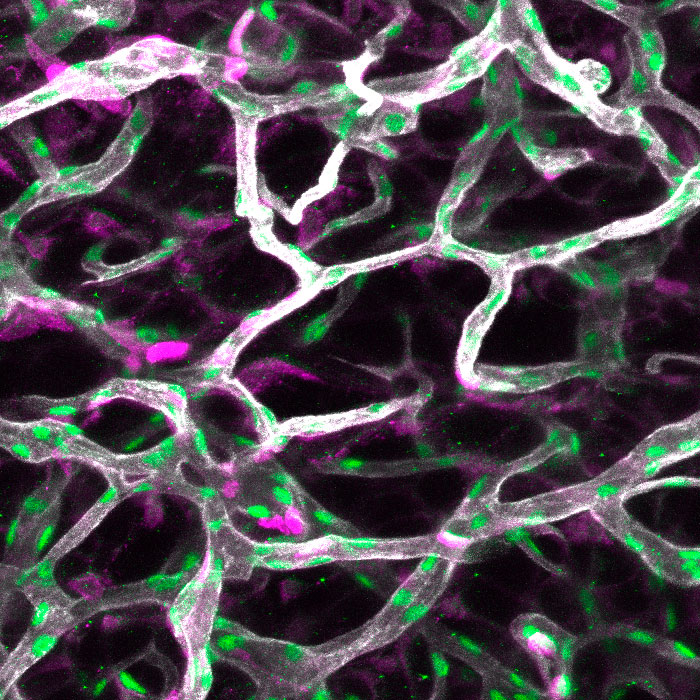
2022/03/14
A study identifies obesity-regulating molecular communication guided by blood vessels
Blood vessels seen to be key players in the development of obesity.
Research has revealed a mechanism through which fat cells are instructed by cells in blood vessels.
The study, co-led by Drs Mariona Graupera and Arkaitz Carracedo, has been published in the journal Nature Metabolism.
The abundance and function of blood vessels in adipose tissue determines the development of obesity. This is the surprising conclusion drawn from a study led by laboratories at the Josep Carreras Leukaemia Research Institute and CIC bioGUNE, both members of the Centre for Network Biomedical Research on Cancer (CIBERONC), and part of a research team funded by the Science Foundation of the Spanish Association Against Cancer (AECC).
Obesity, a multifactorial epidemic disease closely related to the development of multiple pathologies, is caused by the exacerbated expansion of adipose tissue. The development of strategies for the prevention and treatment of this disease is, therefore, an urgent biomedical need. Though adipose tissue displays significant blood supply requirements, the contribution of blood vessels to the development of obesity had not been fully understood until now. The laboratory led by Dr. Graupera is internationally renowned for research into the regulation and function of blood vessels, which is conducted through the development of genetically modified animal models.
To clarify the contribution of blood vessels to the development of obesity, the laboratories led by Drs. Graupera and Carracedo studied a mouse model with increased vascular functionality, and observed that these animals showed resistance to the development of obesity. “At that point, we knew that the blood vessels were instructing the organism to control fat management”, says Dr. Graupera. From here on, the research tandem focused their efforts on identifying the mechanism through which the vessels converse with adipose tissue. "It has been a process in which we have had to resort to cancer to understand obesity," says Dr. Carracedo.
The research leaders engaged international experts from different disciplines in the project, with a view to providing a comprehensive answer to the phenomenon they had described. Years of research have led to the conclusion that blood vessels use a communication language based on small molecules, known as metabolites, to instruct adipose tissue. The adipocytes, in response to the message from the blood vessels, release fats, which the vessels take up as food to proliferate. “It is paradoxical that the mechanism by which the vessels produce these metabolites is identical to the one we recently described in the context of prostate cancer”, Dr. Carracedo continues. Furthermore, as Dr. Graupera adds, “while the vessels activate this process during a controlled increase in proliferation, tumour cells do so in an uncontrolled and aberrant manner”.
This study sheds light on the importance of blood vessels in regulating health and disease in our bodies. “Vessels have historically been considered as inert tubes for transporting blood, but we are discovering that they sense alterations in our body and respond by regulating and organising the function of multiple tissues”, Dr. Graupera concludes. “The fact that vessels respond differently in each organ suggests that we are dealing with a tissue that specialises throughout our organism. This opens up exciting opportunities to improve human health through the regulation of blood vessels”.
Teams from CIC bioGUNE and the Josep Carreras Leukaemia Research Institute have worked in close collaboration with Rubén Nogueiras from CIMUS in Santiago de Compostela, Marc Claret from IDIBAPS in Barcelona and Paul Cohen from Rockefeller University in New York.
Mariona Graupera is Head of the Endothelial Pathobiology Research Group.
Arkaitz Carracedo is Head of the Signalling and Metabolism in Cancer Research Group, and an Ikerbasque research professor.
About the Josep Carreras Leukaemia Research Institute
The Josep Carreras Leukaemia Research Institute conducts research into the epidemiological, preventive, clinical, translational and basic aspects of leukaemia and other haematological malignancies through innovation, with a view to achieving a cure. It is a multi-campus research centre of excellence, a world leader, contributing to the improvement of results and the cure of patients affected by leukaemia and other haematological malignancies, through innovation, sustainability, social responsibility, talent and professional experience.
About CIC bioGUNE
The Centre for Cooperative Research in Biosciences (CIC bioGUNE), located in the Bizkaia Technology Park, is a biomedical research organisation conducting cutting-edge research at the interface between structural, molecular and cell biology, with a particular focus on the study of the molecular bases of disease, for use in the development of new diagnostic methods and advanced therapies.
About BRTA
The BRTA is an alliance made up of 4 collaborative research centres (CIC bioGUNE, CIC nanoGUNE, CIC biomaGUNE and CIC energiGUNE) and 12 technology centres (Azterlan, Azti, Ceit, Cidetec, Gaiker, Ideko, Ikerlan, Lortek, Neiker, Tecnalia, Tekniker and Vicometch), with the aim of developing advanced technological solutions for Basque companies.
With the support of the Basque Government, the SPRI Group and the Provincial Councils of the three regional provinces, the alliance seeks to promote collaboration among its centres, to strengthen the conditions to generate and transfer knowledge to companies, contributing to their competitiveness, and to spread Basque scientific and technological capacity outside of the Basque Country.
BRTA has a staff of 3,500 professionals, accounts for 22% of the Basque Country’s R&D investment, generates an annual turnover of over EUR 300 million and files 100 European and international patents per year.
See a large version of the first picture





